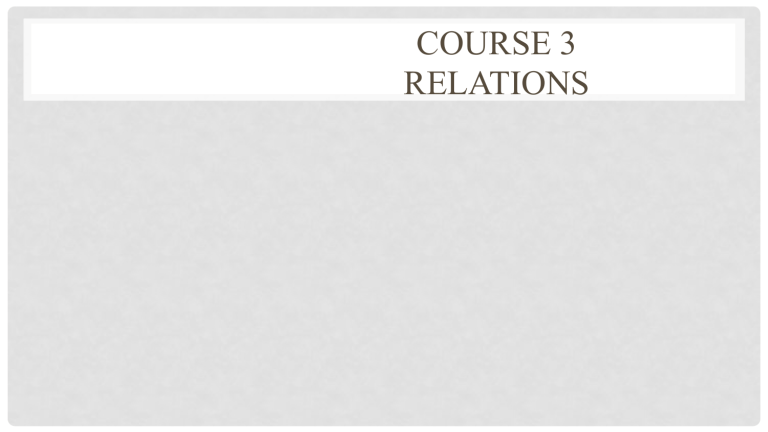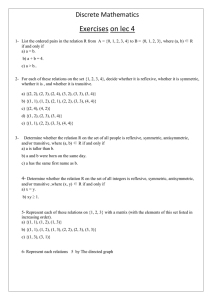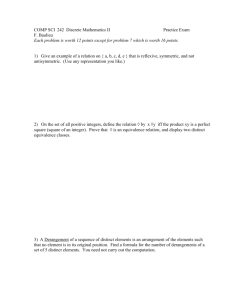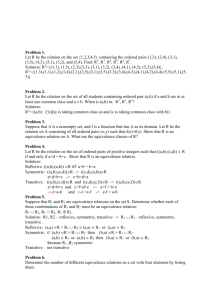
COURSE 3 RELATIONS SUMMARY Some definitions Types of Relations Some examples Equivalence relation Order relation Total and partial order Orders on ℕ × ℕ DEFINITION Definition 1 A relation ℛ on a set 𝐸 is defined by any subset Γ of 𝐸 × 𝐸. When (𝑥, 𝑦) ∈ Γ, we say that 𝑥 is related to 𝑦 via ℛ, and we write 𝑥ℛ𝑦. Γ is called « the graph of the relation ℛ ». EXAMPLES Example 1 : Let 𝐸 = ℝ and define the relation ℛ1 by ∀𝑥, 𝑦 ∈ ℝ, 𝑥 ℛ1 y ⟺ 𝑥 = 𝑦. The graph of ℛ1 is Γ= 𝑥, 𝑥 ; 𝑥 ∈ ℝ EXAMPLES Example 2 : Let 𝐸 = ℕ∗ = 1,2,3, ⋯ , and ℛ2 be the relation defined by ∀𝑥, 𝑦 ∈ ℕ∗ , 𝑥ℛ2 y⟺ 𝑥|𝑦. We have 𝑥|𝑦 ⟺ ∃𝑘 ∈ ℕ∗ such that 𝑦 = 𝑘𝑥. The graph of ℛ2 is Γ = 𝑥, 𝑘𝑥 ; 𝑥, 𝑘 ∈ ℕ∗ TYPES OF RELATIONS Let ℛ be a relation on a the nonempty set 𝐸. Definition 2 We say that ℛ is reflexive if ∀𝑥 ∈ 𝐸, 𝑥ℛ𝑥. TYPES OF RELATIONS Definition 3 We say that ℛ is symmetric if ∀𝑥, 𝑦 ∈ 𝐸, 𝑥ℛ𝑦 ⟹ 𝑦ℛ𝑥. TYPES OF RELATIONS Definition 4 We say that ℛ is transitive if ∀𝑥, 𝑦, 𝑧 ∈ 𝐸, (𝑥ℛ𝑦 ∧ 𝑦ℛ𝑧) ⟹ 𝑥ℛ𝑧. TYPES OF RELATIONS Definition 5 We say that ℛ is antisymmetric if ∀𝑥, 𝑦 ∈ 𝐸, (𝑥ℛ𝑦 ∧ 𝑦ℛ𝑥) ⟹ 𝑥 = 𝑦. EXAMPLES The relation ℛ1 in example 1, defined by ∀𝑥, 𝑦 ∈ ℝ, 𝑥 ℛ1 y ⟺ 𝑥 = 𝑦, is • reflexive, • symmetric, • transitive, • antisymmetric. EXAMPLES Indeed, We have 𝑥 = 𝑥, ∀𝑥 ∈ 𝐸. If 𝑥 = 𝑦 then y = 𝑥, ∀𝑥, 𝑦 ∈ 𝐸. If 𝑥 = 𝑦 and 𝑦 = 𝑧, then 𝑥 = 𝑧, ∀𝑥, 𝑦, 𝑧 ∈ 𝐸. If 𝑥 = 𝑦 and 𝑦 = 𝑥 then 𝑥 = 𝑦, ∀𝑥, 𝑦 ∈ 𝐸. EXAMPLES The relation ℛ2 , defined in example 2 by ∀𝑥, 𝑦 ∈ ℕ∗ , 𝑥ℛ2 y⟺ 𝑥|𝑦. is • reflexive, • Transitive, • antisymmetric. EXAMPLES Indeed, • reflexive : ∀𝑥 ∈ ℕ∗ , 𝑥|𝑥, then 𝑥ℛ2 𝑥. • transitive : ∀𝑥, 𝑦, 𝑧 ∈ ℕ∗ , 𝑥|𝑦 ⟺ ∃ 𝑘 ∈ ℕ∗ such that = 𝑘𝑥, 𝑦|𝑧 ⟺ ∃ 𝑘′ ∈ ℕ∗ such that z= 𝑘 ′ 𝑦 . EXAMPLES We have then 𝑧 = 𝑘 ′ 𝑘𝑥. Setting 𝑘 ′′ = 𝑘 ′ 𝑘, we have 𝑧 = 𝑘 ′′ 𝑥, where 𝑘′′ ∈ ℕ∗ . Therefore 𝑥 ℛ2 𝑧. EXAMPLES • Antisymmetric : ∀𝑥, 𝑦 ∈ ℕ∗ , 𝑥|𝑦 ⟺ ∃ 𝑘 ∈ ℕ∗ such that 𝑦 = 𝑘𝑥, 𝑦|𝑥 ⟺ ∃ 𝑘′ ∈ ℕ∗ such that 𝑥 = 𝑘 ′ 𝑦. EXAMPLES We have then 𝑥 = 𝑘 ′ 𝑘𝑥. It follows that 𝑥 1 − 𝑘 ′ 𝑘 = 0. Since 𝑥 ≠ 0 then 1 − 𝑘 ′ 𝑘 = 0. Now, as 𝑘 et 𝑘′ are positive integers, we have 𝑘 ′ 𝑘 = 1 ⟺ 𝑘′ = 𝑘 = 1. Hence 𝑥 = 𝑦. EXAMPLES We show now that the relation ℛ2 is not symmetric. We have ℛ2 is symmetric ⟺ ∀𝑥, 𝑦 ∈ ℕ∗ , 𝑥|𝑦 ⟹ 𝑦|x, EXAMPLES Then ℛ2 is not symmetric ⟺ ∃𝑥, 𝑦 ∈ ℕ∗ : 𝑥 ℛ2 y and ¬(𝑦ℛ2 x). EXAMPLES This last statement is true, Indeed, for 𝑥 = 2, 𝑦 = 4, we have 2 divides 4, but 4 does not divide 2. Therefore, ℛ2 is not symmetric. EXAMPLES Warning ! The notions of symmetric and antisymmetric are not opposite. EXAMPLES Example 3 Consider the relation ℛ3 defined on ℝ by ∀𝑥, 𝑦 ∈ ℝ, 𝑥ℛ3 𝑦 ⟺ 𝑥 2 ≤ 𝑦 2 . • ℛ3 is not symmetric because ∃𝑥, 𝑦 ∈ ℝ, 𝑥 = −1, 𝑦 = 2, such that 1 ≤ 4 and 4 > 1. EXAMPLES • ℛ3 is not antisymmetric. Indeed, ∃𝑥, 𝑦 ∈ ℝ, 𝑥 = −2, 𝑦 = 2, such that 𝑥ℛ3 𝑦 since 4 ≤ 4 and 𝑦ℛ3 𝑥 since 4 ≤ 4, and we have −2 ≠ 2. EXAMPLES Example 4 Let 𝐸 be a nonempty set and let ℘ 𝐸 be the power set of 𝐸. Let ℛ4 be the inclusion relation defined on ℘ 𝐸 as follows : ∀𝐴, 𝐵 ∈ ℘ 𝐸 , 𝐴 ℛ4 𝐵 𝐴 ⊆ 𝐵. EXAMPLES • ℛ4 is reflexive since ∀𝐴 ∈ ℘ 𝐸 , 𝐴 ⊆ 𝐴. EXAMPLES • ℛ4 is not symmetric because if 𝐸 = 1,2,3,4 , 𝐴 = 3 and 𝐵 = 1,3 , we have 𝐴 ⊆ 𝐵 , then 𝐴 ℛ4 𝐵. Since 𝐵 is not contained in 𝐴, we obtain ¬( 𝐵 ℛ4 A). EXAMPLES • ℛ4 is antisymmetric since ∀𝐴, 𝐵 ∈ ℘ 𝐸 , 𝐴 ℛ4 𝐵 and 𝐵 ℛ4 𝐴 ⟹ 𝐴 = 𝐵. Indeed, we have 𝐴 ℛ4 𝐵 ⟺ 𝐴 ⊆ 𝐵 and 𝐵 ℛ4 A ⟺ 𝐵 ⊆ 𝐴. Therefore 𝐴 = 𝐵. EXAMPLES • ℛ4 is transitive since ∀𝐴, 𝐵, 𝐶 ∈ ℘ 𝐸 , if 𝐴 ⊆ 𝐵 and 𝐵 ⊆ 𝐶, then 𝐴 ⊆ 𝐶. EQUIVALENCE RELATION Definition 6 Let 𝐸 be a nonempty set, and let ℛ be a relation defined on 𝐸. Then ℛ is said to be an equivalence relation if it is reflexive, symmetric and transitive. EXAMPLES • • • • The equality relation ℛ1 is an equivalence relation. The divisibility relation ℛ2 is not an equivalence relation. The relation ℛ3 is not an equivalence relation. The inclusion relation ℛ4 is not an equivalence relation. EQUIVALENCE CLASS • Definition 7 • Let ℛ be an equivalence relation defined on the nonempty set 𝐸 and let 𝑥 ∈ 𝐸. The set of elements in 𝐸 that are related to 𝑥 is called equivalence class of 𝑥, or class of 𝒙 modulo 𝓡, and denoted by 𝑥. • We then write 𝑥 = 𝑦 ∈ 𝐸: 𝑦ℛ𝑥 . QUOTIENT SET Definition 8 Let ℛ be an equivalence relation on a nonempty set 𝐸. The set of equivalence classes is called the quotient set of 𝑬 modulo 𝓡. It is denoted by 𝐸/ℛ. THE QUOTIENT SET ℤ/5ℤ Example 5 We define on the set of integers ℤ the relation ℛ, called congruence relation modulo 5, by ∀𝑥, 𝑦 ∈ ℤ, 𝑥ℛy⟺ ∃𝑘 ∈ ℤ, 𝑥 − 𝑦 = 5𝑘. This is an equivalence relation. There are five equivalence classes : THE QUOTIENT SET ℤ/5ℤ 0 = 5𝑘; 𝑘 1 = 5𝑘 + 1; 2 = 5𝑘 + 2; 3 = 5𝑘 + 3; 4 = 5𝑘 + 4; ∈ ℤ 𝑘∈ ℤ 𝑘∈ ℤ 𝑘∈ ℤ 𝑘∈ ℤ THE QUOTIENT SET ℤ/5ℤ When 𝑥 is related to 𝑦, we write 𝑥≡𝑦5 and we read this as "𝒙 is congruent to 𝒚 modulo 𝟓". The quotient set is denoted ℤ/5ℤ instead of ℤ/ℛ. FUNDAMENTAL PROPERTIES Theorem 1 Let ℛ be an equivalence relation on the nonempty set 𝐸. Then we have : 1) If 𝑦 ∈ 𝑥, then 𝑥 = 𝑦. 2) For all 𝑥, 𝑦 ∈ 𝐸, 𝑥ℛ𝑦 ⟺ 𝑥 = 𝑦. 3) If 𝑢, 𝑣 ∈ 𝑥, then 𝑢ℛ𝑣. 4) For all 𝑥, 𝑦 ∈ 𝐸, we have 𝑥 = 𝑦 or 𝑥 ∩ 𝑦 = ∅. THE QUOTIENT SET ℤ/𝑛ℤ Proposition 1 Let 𝑛 be a positive integer, and consider the equivalence relation ℛ defined on ℤ by ∀𝑥, 𝑦 ∈ ℤ, 𝑥ℛy⟺ ∃𝑘 ∈ ℤ, 𝑥 − 𝑦 = 𝑛𝑘. Then, the quotient set is given by ℤ/𝑛ℤ = 0, 1, 2, ⋯ , 𝑛 − 1 . PARTITION OF A SET Definition 9 Let 𝐸 be a nonempty set and let 𝐹 be a subset of the power set ℘ 𝐸 . We say that 𝐹 is a partition of 𝐸 if the following three conditions are satified : 1) ∅ ∉ 𝐹 2) ∀𝐴, 𝐵 ∈ 𝐹, 𝐴 ≠ 𝐵 ⟹ 𝐴 ∩ 𝐵 = ∅ 3) 𝐴∈𝐹 𝐴 = 𝐸 EXAMPLE • Example 6 • Let 𝐸 = 1, 2, 3, 4 and set • 𝐴 = 1 , 𝐵 = 2,3 , 𝐶 = 4 • 𝐹 = 𝐴, 𝐵, 𝐶 . • 𝐹 is a partition of 𝐸. EXAMPLE • Example 7 • Let 𝐸 = 1, 2, 3, 4 and set • 𝐷 = 1, 2, 4 , G= 3 . • 𝐹 = 𝐷, ∅, 𝐺 is not a partition of 𝐸 since the empty set belongs to 𝐹. EQUIVALENCE CLASSES AND PARTITION Theorem 2 Let 𝐸 be a nonempty set and let ℛ be an equivalence relation on 𝐸. Then the quotient set 𝐸/ℛ forms a partition of 𝐸. Conversely, every partition of 𝐸 defines an equivalence relation on 𝐸. ORDER RELATION Definition 10 Let 𝐸 be a nonempty set, and let ℛ be a relation defined on 𝐸. ℛ is said to be an order relation if it is reflexive, antisymmetric and transitive. EXAMPLES • The equality relation ℛ1 is an order relation. • The divisibility relation ℛ2 is an ordre relation. • The relation ℛ3 is not an order relation. • The relation ℛ4 is an order relation. PARTIAL AND TOTAL ORDER Definition 11 Let 𝐸 be a nonempty set. An order relation defined on 𝐸, denoted by ≼, is said to be a total order relation if we have ∀𝑥, 𝑦 ∈ 𝐸, 𝑥 ≼ 𝑦 ∨ 𝑦 ≼ 𝑥. We then say that (𝐸, ≼) is a totally ordered set. Definition 12 When the order is not total, we say it is partial. EXAMPLES Example 8 The usual order ≤ on the set of real numbers is a total order relation, since we have ∀𝑥, 𝑦 ∈ ℝ, 𝑥 ≤ 𝑦 ∨ 𝑦 ≤ 𝑥. EXAMPLES Example 9 The inclusion relation ℛ4 defined in Example 4 on ℘ 𝐸 is a partial order relation. Indeed, taking 𝐸 = 1,2,3,4 , 𝐴 = 3 and 𝐵 = 1,2 , we have (𝐴 ⊈ 𝐵) ∧(𝐵 ⊈ 𝐴). EXAMPLES Example 10 The divisibility relation on ℕ∗ (Example 2) is a partial order relation. Indeed, ∃𝑥 = 2, 𝑦 = 3 ∈ ℕ∗ , such that 2 ∤ 3 et 3 ∤ 2. SPECIAL ELEMENTS Let 𝐸 be a nonempty set equipped with an order relation denoted by ≼ and let A be a subset of 𝐸. Definition 13 An upper bound of 𝐴 is an element 𝑀 of 𝐸 verifying ∀𝑥 ∈ 𝐻, 𝑥 ≼ 𝑀. Such an element does not always exist. When it exists, we say that 𝐴 is an upper bounded subset of 𝐸. SPECIAL ELEMENTS Definition 14 A lower bound of 𝐴 is an element 𝑚 of 𝐸 verifying ∀𝑥 ∈ 𝐻, 𝑚 ≼ 𝑥. Such an element does not always exist. When it exists, we say that 𝐴 is a lower bounded subset of 𝐸. SPECIAL ELEMENTS Definition 15 A subset 𝐴 of 𝐸 which is both upper bounded and lower bounded is said to be bounded. Definition 16 A maximal (resp. minimal) element of 𝐴 is an upper ( resp. a lower) bound of A which belongs to A. SPECIAL ELEMENTS Definition 17 A maximal (resp. minimal) element of 𝐴 is an upper ( resp. a lower) bound of A which belongs to A. It is denoted by max 𝐴 , (resp. min(𝐴) Maximal element and minimal element are also known as greatest element and least element of 𝐴, respectively. Proposition 2 If A has a maximal (resp. minimal) element, it is unique. SPECIAL ELEMENTS Definition 18 The least upper bound of 𝐴 is called supremum of 𝐴. When it exists, it is unique and we denote it by sup 𝐴 . The greatest lower bound of 𝐴 is called infimum of 𝐴. When it exists, it is unique and we denote it by inf 𝐴 . SPECIAL ELEMENTS Remark 1 If max(𝐴) (resp. min(𝐴)) exists, then max 𝐴 =sup(𝐴) (resp. min 𝐴 =inf 𝐴 ). The converse is not true in general. EXAMPLE Example 5 Consider the set of real numbers ℝ equipped with the usual order relation ≤ and set 𝐴 = [𝑎, 𝑏[, where 𝑎 < 𝑏. The set of upper bounds of 𝐴 belonging to ℝ is [𝑏, +∞[ The set of lower bounds of 𝐴 belonging to ℝ is] − ∞, 𝑎]. EXAMPLE Then sup 𝐴 = 𝑏 and inf 𝐴 = min 𝐴 = 𝑎. However, max 𝐴 doesn’t exist since we have 𝑏 ∉ 𝐴. ORDERS ON ℕ × ℕ On a given set, we can define several order relations. Definition 19 (Product order) The relation ℛ𝑝 on the cartesian product ℕ × ℕ is defined by ∀ 𝑥, 𝑦 , (𝑥 ′ , 𝑦 ′ ) ∈ ℕ × ℕ, 𝑥, 𝑦 ℛ𝑝 (𝑥 ′ , 𝑦 ′ ) ⟺ 𝑥 ≤ 𝑥′ et 𝑦 ≤ 𝑦′, where ≤ is the usual order relation on ℕ. ORDERS ON ℕ × ℕ Proposition 3 The relation ℛ𝑝 is a partial order relation on ℕ × ℕ. Proof • ℛ𝑝 is reflexive since ∀(𝑥, 𝑦) ∈ ℕ × ℕ, we have 𝑥 ≤ 𝑥 and 𝑦 ≤ 𝑦, then (𝑥, 𝑦) ℛ𝑝 x, y . ORDERS ON ℕ × ℕ • ℛ𝑝 is transitive because ∀ 𝑥, 𝑦 , 𝑥 ′ , 𝑦 ′ , 𝑥",y" ∈ ℕ × ℕ, 𝑥, 𝑦 ℛ𝑝 𝑥 ′ , 𝑦 ′ ⟺ 𝑥 ≤ 𝑥 ′ ∧ 𝑦 ≤ 𝑦 ′ , and 𝑥 ′ , 𝑦 ′ ℛ𝑝 𝑥",y" ⟺ 𝑥′ ≤ 𝑥" ∧ 𝑦′ ≤ 𝑦". ORDERS ON ℕ × ℕ Therefore 𝑥 ≤ 𝑥" et 𝑦 ≤ 𝑦". That is 𝑥, 𝑦 ℛ𝑝 𝑥",y" . ORDERS ON ℕ × ℕ • ℛ𝑝 is antisymmetric. Indeed, ∀ 𝑥, 𝑦 , 𝑥 ′ , 𝑦 ′ ∈ ℕ × ℕ, we have 𝑥, 𝑦 ℛ𝑝 𝑥 ′ , 𝑦 ′ ⟺ 𝑥 ≤ 𝑥 ′ ∧ 𝑦 ≤ 𝑦 ′ and 𝑥′, 𝑦′ ℛ𝑝 𝑥, 𝑦 ⟺ 𝑥 ′ ≤ 𝑥 ∧ 𝑦 ′ ≤ 𝑦. ORDERS ON ℕ × ℕ We have 𝑥 ≤ 𝑥 ′ ∧ 𝑥 ′ ≤ 𝑥 ⟺ 𝑥 = 𝑥′ and 𝑦 ≤ 𝑦 ′ ∧ 𝑦 ′ ≤ 𝑦 ⟺ 𝑦 = 𝑦′. Hence 𝑥, 𝑦 = (𝑥 ′ , 𝑦 ′ ). ORDRES SUR ℕ × ℕ (7) The order is partial because ∃ 𝑥, 𝑦 , (𝑥 ′ , 𝑦 ′ ) ∈ ℕ × ℕ, ¬ 𝑥, 𝑦 ℛ𝑝 x ′ , y ′ ¬ ∧ 𝑥 ′ , 𝑦 ′ ℛ𝑝 x, y . ORDERS ON ℕ × ℕ It suffices to take 𝑥, 𝑦 = 5,4 and 𝑥 ′ , 𝑦 ′ = (3,6). Then we obtain ¬ 5,4 ℛ𝑝 3,6 ∧¬ 3,6 ℛ𝑝 5,4 . ORDERS ON ℕ × ℕ Definition 20 (Lexicographic order) The relation ℛ𝑙 on the cartesian product ℕ × ℕ is defined by ∀ 𝑥, 𝑦 , (𝑥 ′ , 𝑦 ′ ) ∈ ℕ × ℕ, 𝑥, 𝑦 ℛ𝑙 𝑥 ′ , 𝑦 ′ ⟺ (𝑥 < 𝑥 ′ ) ∨ (𝑥 = 𝑥′ ∧ 𝑦 ≤ 𝑦′), where ≤ is the usual order relation on ℕ. ORDERS ON ℕ × ℕ Proposition 4 The relation ℛ𝑙 is a total order relation on ℕ × ℕ. Remark 2 The lexicographic order, generalized to 𝑛-uples of letters of any length is the one used to classify the words in the dictionary.




